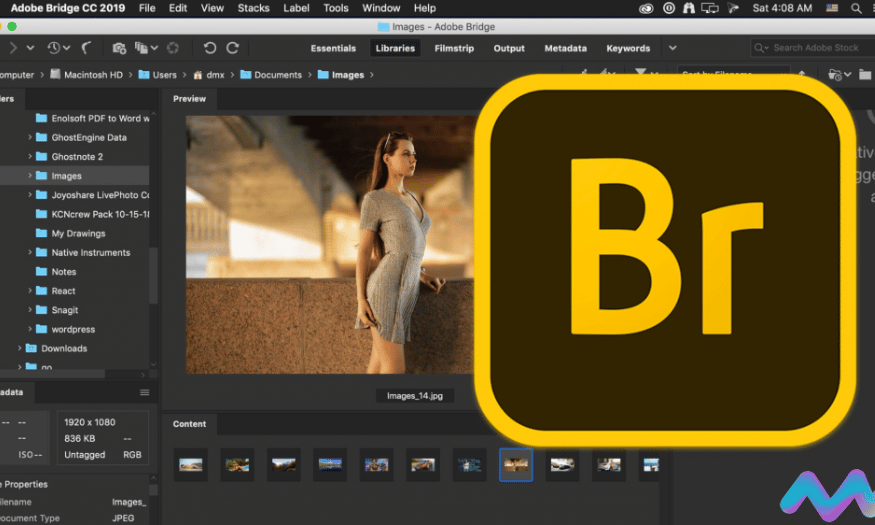Best Selling Products
15 Outstanding Features of Adobe Bridge You Should Not Miss
Nội dung
- 1. File management system
- 2. Image view mode
- 3. File Browser
- 4. Preview image
- 5. Image filtering feature
- 6. Batch rename
- 7. Quick access to Photoshop
- 8. Metadata management
- 9. Collection creation feature
- 10. Flexible file export feature
- 11. Slideshow creation feature
- 12. RAW format support
- 13. Multi-language support
- 14. Sync feature
- 15. File sharing feature
- 16. Conclusion
In today's creative world, effective management of multimedia assets is a crucial factor for designers, photographers, and media artists to optimize their workflow. Adobe Bridge is one of the leading tools that helps users organize, view, and edit documents easily and efficiently. With a variety of outstanding features, Adobe Bridge is not only a file management application but also a powerful assistant in the creative process.

In today's creative world, effective management of multimedia resources is a very important factor for designers, photographers and media artists to optimize their workflow. Adobe Bridge is one of the leading tools that helps users organize, view and edit documents easily and effectively. With a variety of outstanding features, Adobe Bridge is not only a file management application but also a powerful assistant in the creative process. In this article, Sadesign will explore with you 15 outstanding features of Adobe Bridge, thereby helping you better understand the power of this tool.
1. File management system
A File Management System is a solid foundation for working effectively with digital resources in today's technological age. It not only helps organize and classify files, but also ensures that users can quickly search and access the necessary documents, especially when faced with huge volumes of data. A complete file management system usually includes features such as file location, folder creation, access management, and quick preview capabilities, thereby providing a smooth user experience.
Using a professional file management system like Adobe Bridge not only helps optimize workflow but also enhances user creativity and productivity. With Adobe Bridge, you can easily organize documents, saving you time and energy for more creative work. That is why an effective file management system becomes an essential part of every creative workflow.
.png)
2. Image view mode
Image Review Mode in Adobe Bridge provides an incredibly easy and flexible preview experience. When users select this mode, they can quickly and conveniently view image details, optimizing the image review and selection process. This is especially useful when working with multiple files at once, where it can be difficult to differentiate and select between images.
Flexible controls along with the ability to zoom and rotate images help users to check and evaluate every detail easily. Thanks to the image view, choosing the right photos for the project is easier than ever. This is one of the important features that helps improve the working efficiency and quality of image management in the user's creative process.
.png)
3. File Browser
The File Browser is an important feature in Adobe Bridge, providing a powerful file browsing and management experience. With the File Browser, users can easily view and organize files and folders. This feature provides a comprehensive view of the folder and file structure, helping users quickly locate and open the necessary files without encountering unnecessary troubles.
In addition, the file browser also supports multiple sorting, filtering, and searching options, helping users to streamline their workflow and save valuable time. Drag and drop operations are also integrated to easily move and organize files. With preview capabilities, the file browser gives users an overview and details of the content of files, thereby optimizing their workflow and managing their digital assets.
4. Preview image
As users browse through image files, Image Previews automatically generates high-quality previews. This allows users to quickly evaluate the content of an image without opening the detailed file, saving time and effort in resource management.
This feature provides an overview and makes it easy to evaluate the quality, content, and fine details of each image. This increases efficiency in the process of selecting and managing images, especially when there are large files to review. When you can quickly identify which images are suitable for your project, you will have more time to focus on developing ideas and creating quality content.
.png)
5. Image filtering feature
Filtering Images in Adobe Bridge is a powerful tool that helps users quickly search and sort images according to specific criteria, thereby optimizing the resource management process. With the ability to apply flexible filters, users can easily display only the necessary images, helping to eliminate irrelevant files from the list, thereby focusing on what is really important. This feature not only saves time but also improves work efficiency, especially when you are dealing with a large volume of images.
One of the biggest advantages of this feature is the ability to refine filters to narrow down the results. Users can set criteria such as size, file type, date created, and more to quickly find the most suitable images for their projects. Thanks to the image filtering feature, file management and processing become more efficient than ever, helping you quickly complete your work without being distracted by unnecessary files.
.png)
6. Batch rename
Batch Rename in Adobe Bridge is an indispensable tool for those who regularly work with large numbers of image files. Instead of having to rename each file manually, this feature allows users to automatically apply naming rules to quickly and accurately perform renaming, optimizing the file management process. This is especially useful when you need to name hundreds or even thousands of images consistently.
Batch renaming not only saves time but also brings consistency to resource management. You can easily set up custom naming patterns, which ensures consistency and makes searching easier later. Batch renaming helps users handle graphic files efficiently and professionally, ensuring that all documents are organized and easily accessible.
.png)
7. Quick access to Photoshop
The quick access feature of Photoshop in Adobe Bridge provides a seamless working experience for users when they need to edit images. Instead of having to open Adobe Photoshop first and then search for files in folders, users can now open files from Adobe Bridge directly into Photoshop with just one click. This not only saves time but also helps optimize the workflow, especially for those working in the field of graphic design that requires quickness and efficiency.
This feature makes it easy for users to switch between Adobe Bridge and Adobe Photoshop, making necessary edits quickly and efficiently. By tightly integrating the two applications, Adobe Bridge becomes more than just a file management tool, but an integral part of your creative workflow, allowing you to focus on developing ideas without being distracted by complicated procedures.
.png)
8. Metadata management
Metadata management in Adobe Bridge allows users to easily add, edit, and organize information about each image file. Metadata includes information such as author, creation date, location, and keyword tags, giving users a comprehensive view of the document they are working on. Metadata management not only makes it easier to search and categorize images, but also enhances copyright protection and intellectual property management.
With Adobe Bridge, users can quickly access and edit metadata fields without having to open each file individually. This saves time and increases efficiency in asset management. Furthermore, smart use of metadata can improve image search and classification in the future, ensuring that you always have access to important information when needed.
9. Collection creation feature
The collection feature in Adobe Bridge allows users to group image files together according to specific themes or projects. This is extremely useful when you are working on multiple projects at once or when you need to organize images in a systematic way. Users can easily add or remove files from a collection without changing their original location, giving you flexibility in managing and accessing your resources.
By using the collection feature, users can easily share ideas or present projects to colleagues or clients. Organizing images into collections not only saves you time but also enhances creativity, making it easier to find the right images for each specific situation.
10. Flexible file export feature
Flexible file export in Adobe Bridge allows users to easily export image files to a variety of formats or send them to other applications in the Adobe suite. You can export images as JPEG, TIFF, PNG, or other formats depending on your needs, ensuring that your assets are ready for any project.
Not only does this save time, it also ensures that you can use your images in a variety of contexts, from print to online presentations. Flexible file exporting helps streamline your workflow and ensures that you always have access to the file formats you need, no matter what your project is.
11. Slideshow creation feature
The slideshow feature in Adobe Bridge is a great tool for users to present images in an attractive and visual way. You can easily create vivid visual presentations, helping to effectively share ideas or works with colleagues and customers. This feature allows you to customize the display time of each image, add background music and transition effects, thereby creating an impressive and professional viewing experience.
By using the slideshow feature, you can easily present collections of images, making it easy for viewers to grasp the content and message you want to convey. This is a very useful tool in meetings, seminars, or any situation where you need to present your ideas visually and vividly.
.png)
12. RAW format support
The RAW format support feature in Adobe Bridge is one of the outstanding strengths of this tool, especially for professional photographers. RAW format allows to store more information about the image, helping to ensure the best quality for the photos. Adobe Bridge allows users to view, manage and edit RAW files from many different types of cameras without losing image quality.
RAW format support makes it easy for users to review and select the best photos for editing, and facilitates image processing in Adobe Camera RAW. Thanks to this feature, you can rest assured that every subtle detail will be preserved, helping you to be creative and get the most out of each photo.
13. Multi-language support
The multilingual support feature in Adobe Bridge brings convenience to users around the world. With the ability to switch the interface into many different languages, users can easily get acquainted with the application without encountering language barriers. This not only enhances the user experience but also helps increase work efficiency for users who do not speak English.
This feature is very important in the context of globalization, when users from many different countries use the same tool. By supporting multiple languages, Adobe Bridge helps users feel more comfortable working and exploiting the software's features without worrying about misunderstanding instructions or features.
14. Sync feature
The synchronization feature in Adobe Bridge allows users to keep files and collections up to date across multiple devices. This is extremely useful when you work on multiple computers or devices, ensuring that you always have access to the latest assets and don't miss any updates to your projects.
Not only does synchronization save time, it also reduces the risk of losing data or confusing different versions of files. This gives users the peace of mind that they can work flexibly and efficiently, no matter where they are or what device they are using.
.png)
15. File sharing feature
File sharing in Adobe Bridge makes it easy to send resources to colleagues or clients without having to use external storage media. You can share image files, collections, or even slide shows with just a few clicks, saving you time and effort in sending and receiving documents.
This is especially useful in the modern workplace, where quick collaboration and communication are essential. File sharing not only helps you maintain effective working relationships, but also ensures that everyone has access to the information they need to get the job done smoothly.
16. Conclusion
Adobe Bridge is not only a document management tool but also a powerful assistant in your creative workflow. With the 15 outstanding features mentioned above, Adobe Bridge really brings flexibility and efficiency in organizing and managing multimedia resources. If you are looking for a solution to optimize your workflow, try Adobe Bridge today. With the support of this tool, you will be able to focus on creating and developing ideas, instead of worrying about document management. you!












































